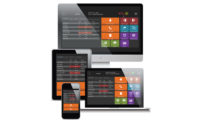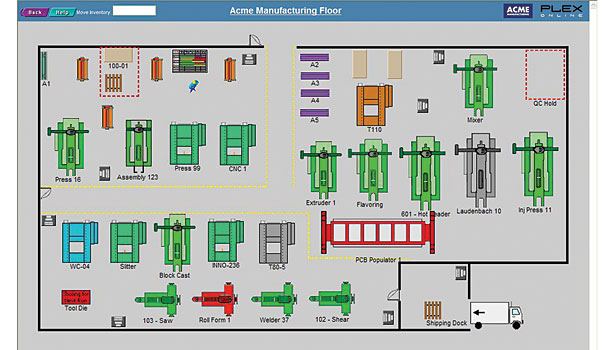Software & Analysis
How Shop-Floor Integration Improves Quality

Screenshot displays integration with other quality modules. It includes instructions, gage controls information, quality alerts and access to the latest revisions of documents in the document control system. Source: Plex Systems

This screenshot displays the operational status of machines on the shop floor. Operators can manually enter in machine states that will drive the display or the data can be dynamically driven from plant floor machines integrated with programmable logic controllers (PLCs). Source: Plex Systems

A machine operator is seen at work with a monitor displaying relevant production information from a cloud ERP solution nearby. Source: Plex Systems

A monitor displays machine data in real-time on the shop floor, providing operators with details of which parts are produced, as well as quantities and performance metrics. Source: Plex Systems




With today’s software, there is no reason to be unaware of what is happening on the plant floor right now.
As Ford Motor Co.’s slogan used to proclaim, “Quality is Job One.” This is true for every manufacturer and certainly a primary motivator for business enterprises to adopt new technology. Indeed, today high quality of products and services is virtually the price of entry into the market.
Many customers using a Cloud, or SaaS, enterprise resource planning (ERP) solution, discover that integrating it with programmable logic controllers (PLCs) and other machines on the plant floor helps boost quality and reduce cost in a number of ways. They include:
- Greater accuracy and accountability;
- Real-time awareness of changing plant floor conditions;
- Improved traceability; and
- More accurate inventory tracking.
A telling example of how PLC integration with a SaaS solution can improve quality and productivity is provided by a major automotive parts supplier. It leverages software integration with shop floor machines through the PleXML solution provided by Kors Engineering. This system displays in vivid color the performance of individual production lines. The display color ranges from green to red in gradients, based on current efficiency of the line; the poorer the line is operating, the redder the line.
Tech Tips
|
ERP Deployed
Why should manufacturers deploy ERP systems to the shop floor and integrate them with PLCs?
To apply the same lean quality improvements to data as companies apply to the products manufactured.
To enable the top floor to manage the plant floor through business controls that ensures accuracy
and accountability.
With improved information and business controls in place at the point of production, the plant floor is better able to self-manage and to improve responsiveness to changing conditions or quality issues at the place and time of origin.
This also leads to the highest levels of data quality, accuracy, delivery and storage. Incorrect data from the plant floor can be more destructive than no data at all, but accurately captured real-time data will quickly expose plant-floor deficiencies and anomalies of OEE, quality and traceability—even during the shift and before ripple effects from those problems can extend beyond their source.
Allowing an ERP system to effectively automate a process not only results in a nearly perfect production process—it also frees an operator to focus on other, value-added activities. When additional data is captured, the shop floor is integrated with the top floor for a real-time snapshot of traceability and machine output.
ERP and PLC integration on the shop floor brings many opportunities for improvement. Higher quality, decreased scrap and increased production throughput are positively impacted by deployment of an ERP system on the shop floor.
“A Single Version of the Truth”
A provider of metal stampings and welded assemblies for automotive OEMs is an example of a company that tied together its PLCs and other shop-floor machines—to access a “single version of the truth.”
Its inventory accuracy prior to adopting Cloud ERP with PLC integration was only about 50%, forcing the company to aggressively pursue technology solutions to better manage inventory. Employees conducted grueling physical inventories every month, and the numbers would be off within the following week. They never knew if they had enough parts to build a setup. And every time they did a setup, it was different. Each of their staff had his or her method, which resulted in lost time, inconsistent product quality, scrap, rework, excessive tool costs and costly last minute shipments.
Adoption of a Cloud-based ERP system with plant floor machine integration provided the results they were seeking. With the new system, they could easily match receipts to internal purchase orders, and match purchase orders to invoices. They had more control and security over purchase orders and actually reduced the number of purchase orders. The improved efficiency saved them about $100 per purchase order processed.
Results were immediate and significant:
- Training costs were reduced by more than 50% because all functions in the Cloud ERP solution were available from a consistent interface.
- Premium freight costs reduced by 20% in the first year, greatly cutting the need to purchase costly expedited shipments.
- Scrap rates were reduced by 60%.
They are now able to consistently and accurately record machine processes. Settings for specific parts are automatically entered for tolerances, speed and other critical requirements, which enable a controlled strategy for production. The ERP system ensures that no machine operation is underway until settings are met, significantly reducing scrap, rework and tooling costs.
In addition to increased transparency throughout the enterprise, traceability from station to station allows management to tie into environmental systems and hydraulics to manage entire energy systems.
Before and After
Prior to the introduction of ERP, integrated PLCs and adoption of a formalized platform, the shop floor was dependent on a handful of individuals with specific training and machine knowledge. Now, any shop floor person can leverage the system to set up and run any machine. This knowledge empowers all levels of management and helps drive informed decision making to quickly exploit strengths and correct deficiencies in the system, reduce waste and improve quality. Once the shop floor machines are online, it’s easy to focus resources on improving quality, eliminating waste and working more efficiently. It’s also more difficult to overlook or hide what’s really going on.
The check sheet is integrated with other quality modules that only allow workers to choose a gage that is within calibration specifications. The deviation function creates quality alerts that are accessible by floor personnel, and a document control system ensures that operators always have access to the latest revision at their fingertips.
Today, regardless of where you are, there is no reason to be unaware of what is transpiring on the plant floor right now. Information gathered by PLCs is transmitted instantly to the ERP system, which because of its cloud-based architecture is accessible by portable devices anywhere in the world, at any time. Communication features built into the EPR system, such as automatic notifications and workflow approvals, allow managers to keep the pulse of the company and to execute decisions from home or while on the road.
Looking for a reprint of this article?
From high-res PDFs to custom plaques, order your copy today!









